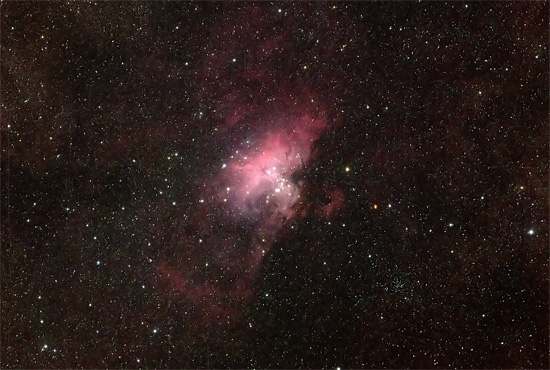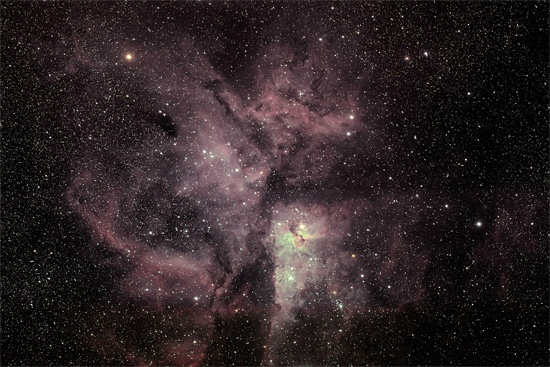Chess and Astronomy
John Nunn
There must be some kind of connection between these two subjects, because when
something astronomical appears on ChessBase there is a positive response from
readers and occasionally some really interesting involvement. That happened
recently during the Anand-Topalov World Championship match. One reader, Dr Christian
Sasse from Vancouver, had noted that both I and Vishy Anand were interested
in astronomy and asked Frederic Friedel to pass on an interesting offer to both
of us. Frederic immediately contacted me, but sensibly decided to wait for Vishy
to retain his World Championship title before doing the same with him.

51-year old Christian is general manager of an electrical engineering company,
an avid amateur astronomer and of course a chess player. He is the owner of
three telescopes which form part of the Global
Rent-a-Scope network, which is a system whereby amateur astronomers can
rent time on telescopes in various places around the world. These telescopes
can be controlled via the Internet and, after the images have been taken, they
can be downloaded and processed by the user. Christian generously offered myself
and Vishy some time on the GRAS telescopes. Vishy is quite busy at the moment,
so I was the first to take the plunge into the world of ‘robotic telescopes’,
as these remote-controlled devices are called.

Here I am in my office, with appropriate reading material by my side, preparing
to control...

Christian’s 16 inch (40 cm) telescope, located in Moorook, South Australia.
The benefits of using a robotic telescope are substantial. I live just outside
London and one of the greatest problems is that of light pollution, the combined
effect of millions of artificial lights blasting up into the sky (wasting a
lot of energy in the process) and then being reflected down to the ground by
small particles in the air. The result is that in and around London and other
cities the night sky is not really dark, but an ugly shade of pink, drowning
out all but the brightest stars. Using a telescope does not help, since it not
only magnifies the images of stars and other objects, but also magnifies the
pink glow. Additionally, I am limited by the traditional English weather, which
practically guarantees that it will be cloudy when there is anything interesting
to observe.
 Using
a robotic telescope alleviates many of the problems. GRAS uses two sites, one
in Mayhill, New Mexico, in the United States and one in Moorook in Australia,
although at least one other site is planned. There are a total of 13 telescopes
available at the two current sites. The New Mexico site is at high altitude
and both sites are situated in areas with dark skies and generally good weather.
The equipment is all maintained by professionals, so the user can focus on the
actual imaging.
Using
a robotic telescope alleviates many of the problems. GRAS uses two sites, one
in Mayhill, New Mexico, in the United States and one in Moorook in Australia,
although at least one other site is planned. There are a total of 13 telescopes
available at the two current sites. The New Mexico site is at high altitude
and both sites are situated in areas with dark skies and generally good weather.
The equipment is all maintained by professionals, so the user can focus on the
actual imaging.
For some people there is a feeling that using a robotic telescope is somehow
‘cheating’, because all the hard work has been done for you, leaving
the user with nothing more difficult to do than press the button. Before I started
I had this feeling to some extent, but I soon realised that there is a lot more
to it than just ‘pressing the button’. There are several telescopes
to choose from, with different capabilities, and it is important to select the
right one for the target object. The ultra-sensitive cameras have cooled sensors
to reduce noise (sometimes down to minus 40 degrees C) and can see much more
than our eyes, enabling us to see beautiful hidden aspects of the universe.
There is a choice of filters, which restrict the light falling into the camera
to particular wavelengths. The numerous filters make imaging more interesting,
since each telescope user can creatively combine colours to produce a more dramatic
final result. There are other parameters you can vary, and you end up with a
set of images of your chosen object, which can then be assembled using software.
This is an art all in itself, as by skilful processing an ordinary-looking image
can be improved into something really spectacular. My earlier astrophotography
with my own telescope did not involve many of these steps, since I used an ordinary
Canon 7D DSLR for imaging, so I had to climb something of a learning curve.
But after a few hours’ study I was able to produce attractive images,
some of which are showcased below.
When using GRAS, it’s also possible to ‘look over the shoulder’
of other users and monitor what they are doing, which can be educational in
itself. It’s fascinating to see what other people are observing. My own
interest lies with deep-sky objects, but I have noticed other users looking
at comets or small bodies at the edge of our solar system. There really are
a lot of interesting things in the sky, if you know where to look. Fortunately,
there are many astronomical catalogues which make it easy to pick out interesting
objects in the immensity of space.
Potentially interested readers will probably want to know something about the
cost of using GRAS. Unfortunately, it’s difficult to give a straightforward
answer to this, since each telescope is charged individually according to its
capabilities. Perhaps the simplest is to say that each image below would cost
about US$15-20 in telescope time. This may sound like a lot, but amateur astronomy
equipment is expensive and to set up your own telescope can easily cost more
than $10,000. The good thing about being charged per use is that you can easily
try it and see whether you like it without making a large investment in both
time and money.
Anyhow, now it’s time to show you what I achieved in my first week using
GRAS. These images are arranged roughly in chronological order so you can see
how the results improved along with my experience. You can click on some of
the images to view a much larger version.

A monochrome image of the large spiral galaxy M101 (often called the Pinwheel
Galaxy), which is about twice the size of the Milky Way, our own galaxy. It’s
a bit over 23 million light-years away.
One of the thrills of using GRAS is that, since it has telescopes in both Northern
and Southern hemispheres, the whole sky is visible. My latitude is 51.5 degrees
North, which means the southern sky is inaccessible. Seeing the impressive objects
in the Southern sky was especially exciting.

This is the large elliptical galaxy Centaurus A, which has a pronounced belt
of dust around its equator. It’s about 14 million light-years away and
is believed to have a supermassive black hole at its centre.

Centaurus A in an expanded extract of the original image

Moving closer to home, this is M16, the Eagle Nebula, a giant cloud of dust
and gas which is
collapsing to form new stars. It’s about 7,000 light-years away and about
70 light-years across.

This is the Carina Nebula, another Southern hemisphere object. It’s a
cloud of dust and gas surrounding a cluster of bright starts. One of these,
Eta Carinae (near the brightest part of the nebula), is a hypergiant star with
about 100-150 times the mass of the Sun, which is near the theoretical maximum
mass for a star – any larger and the star would explode immediately. It
is four million times as luminous as the Sun and is very unstable – indeed
it could explode in a supernova at any time. Fortunately, it’s a safe
distance from us – about 8,000 light years.

Staying in the Southern hemisphere but going a bit further away, this object
is Omega Centauri. Our Milky Way galaxy is surrounded by about 150 so-called
globular clusters, each of which is a densely packed balls of stars in orbit
about the Milky Way. Globular clusters contain almost exclusively very old stars
so they have clearly been around for some time, although how they arose is uncertain.

Omega Centauri (above in an expanded crop from the original image) is by far
the largest of the Milky Way’s globular clusters and contains 10 million
stars. It’s about 16,000 light-years away and is roughly 85 light-years
across.

Global Rent-a-Scope (GRAS) is a global network of remotely operated telescope
systems. Subscribers connect to any of the available worldwide locations and
take their own images. This publicly accessible time rental service is available
through any Internet connection, including dial-up. The initial startup service
began operations in 2001.





















 Using
a robotic telescope alleviates many of the problems. GRAS uses two sites, one
in Mayhill, New Mexico, in the United States and one in Moorook in Australia,
although at least one other site is planned. There are a total of 13 telescopes
available at the two current sites. The New Mexico site is at high altitude
and both sites are situated in areas with dark skies and generally good weather.
The equipment is all maintained by professionals, so the user can focus on the
actual imaging.
Using
a robotic telescope alleviates many of the problems. GRAS uses two sites, one
in Mayhill, New Mexico, in the United States and one in Moorook in Australia,
although at least one other site is planned. There are a total of 13 telescopes
available at the two current sites. The New Mexico site is at high altitude
and both sites are situated in areas with dark skies and generally good weather.
The equipment is all maintained by professionals, so the user can focus on the
actual imaging. 












